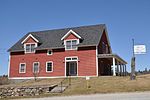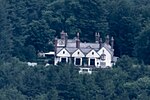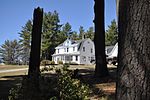Asa Morse Farm
Colonial Revival architecture in New HampshireFarms on the National Register of Historic Places in New HampshireHouses completed in 1926Houses in Dublin, New HampshireHouses on the National Register of Historic Places in New Hampshire ... and 1 more
National Register of Historic Places in Dublin, New Hampshire

The Asa Morse Farm, also known as the Friendly Farm, is a historic farmstead on New Hampshire Route 101 in Dublin, New Hampshire. The main farmhouse, built in 1926 on the foundations of an early 19th-century house, is a good example of Colonial Revival architecture, built during Dublin's heyday as a summer retreat. The farmstead was listed on the National Register of Historic Places in 1983.
Excerpt from the Wikipedia article Asa Morse Farm (License: CC BY-SA 3.0, Authors, Images).Asa Morse Farm
Main Street,
Geographical coordinates (GPS) Address Nearby Places Show on map
Geographical coordinates (GPS)
| Latitude | Longitude |
|---|---|
| N 42.913055555556 ° | E -72.094166666667 ° |
Address
Main Street
Main Street
03450
New Hampshire, United States
Open on Google Maps











